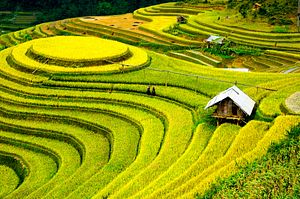This Thursday marks the 69th annual celebration of World Food Day, a day that seeks to remind us of the importance of food security and the imperative of feeding the world’s hungry. Yet while most conversations on World Food Day are likely to focus on the growing role of family farming (it’s this year’s theme), there is an alternative topic on the menu of global food issues that behooves a broader discussion: feeding China.
Indeed, recent trends have made clear that it’s impossible to talk about the future of food without talking about the future of China. Consider that China consumes 50 percent of the world’s pork and 60 percent of the world’s soybeans; it is the world’s largest consumer of wheat and by far the largest consumer of grains. Since 1978, China’s meat consumption has risen from a third of that of the U.S. to more than double today. To be sure, as China’s middle class expands (it is expected to grow to 40 percent of China’s population by 2020), so will its appetite.
These trends lead to some obvious but important questions. Who will feed China? What will China’s increasing appetite mean for the rest of the world? And what will it mean for China?
Let’s consider the first question. It’s probably self-evident that feeding 1.4 billion people will take more resources than China alone has to offer. As Damien Ma and Williams Adams have noted, this would entail “filling the stomachs of 20 percent of humanity with just 8 percent of the world’s arable land and only about 30 percent of the world’s per capita availability of fresh water.” So what is China to do? At least one option is all but unavoidable: to import at an unprecedented scale.
And import China shall. In fact, by 2030 China will import nearly one third of all the food in the world, according to a recent Economist Intelligence Unit report. Go to China today and you are much more likely than in decades past to find yourself eating pork from the U.S., dairy from New Zealand, salmon from Scotland, or packaged food from Israel.
As you might expect, China’s growing appetite for imports has huge ramifications for the rest of the world. Surely, many countries will benefit from a boom in exports to China. Several Mediterranean countries, for example, have gained from China’s acquired taste for olive oil, of which exports have tripled between 2009 and 2013. Similarly, New Zealand’s dairy and forestry contributions to GDP have grown four-fold largely as a result of Chinese demand.
But growing demand from China could also trigger destabilizing price rises, which in turn may lead to food riots and social unrest. According to the World Bank, internationally traded food prices have increased by 4 percent in the first quarter of 2014 – the sharpest increase since 2012 – largely as a result of growing Chinese demand. Keep in mind that since 2007 there have been 57 food riots that have occurred in 35 different countries, primarily as a result of price increases.
Economic considerations notwithstanding, perhaps the most worrisome consequence of China’s growing demand may be borne out in the environment. Nearly 20 percent of China’s arable land has already been degraded by industrial effluent, sewage, and excessive farm chemicals. China’s rivers are suffering too, as demand from farms and factories pollute and suck them dry (one ton of pork consumes 121,000 gallons of water; one ton of beef about 145,000 gallons). But these environmental problems are not bound by China’s borders – carbon emissions, for instance, are certain to soar as more livestock is raised and as more Chinese use refrigerants to preserve their foods.
This may all seem rather bleak. Yet China’s increasing demand does not necessarily mean that we are destined to fall into the Malthusian trap. After all, where there is need, innovation and investment typically follow. China has done particularly well at adopting and integrating modern agricultural technologies, and it has established a formidable agribusiness sector alongside several multinational firms such as DuPont Pioneer and Deere. All of this suggests that China’s agricultural output may be able to maintain steady growth in the years to come.
One more positive note: China’s rise has led to “vastly improved diets” in China, according to the World Bank. This shouldn’t be surprising, as more “affluent” diets typically follow from economic growth. But that millions more Chinese are now able to acquire safer, better-quality food, is a good and noteworthy development.
So this World Food Day, let’s recognize the gravity of China’s increasing appetite. But let’s not ignore the opportunity it presents.
Andy Morimoto is a program coordinator with The Chicago Council on Global Affairs. He holds an MA in international relations from the University of Chicago and a BA in political science and history from The University of North Carolina at Charlotte. Any opinions expressed here are his own and do not represent those of The Chicago Council.

































